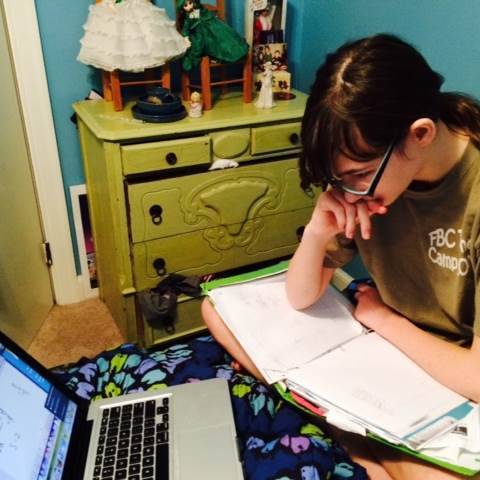Darlington is great at educating but not at weather forecasting. Atlanta’s gridlock made national news then disappeared, but six missing days could mean a serious interruption in the rhythms and content delivery of the school year. But what if studies could continue?
What if, for instance, a U.S. History teacher and his class could watch the State of the Union Address from home and blog live via a Google Doc? What if a math teacher could host a webinar allowing his students to get personalized help as they worked through assignments? These things and many others have been happening this week at Darlington thanks to our faculty’s creative use of technology and our students’ immersion in the tools of distance learning.
When Darlington or any other school prepares for winter weather and contemplates closing, two major issues are under consideration. The very first is the safety of our students, parents and faculty. The second is the disruption of academic progress. Substituting Distance Learning Days for Snow Days is Darlington’s solution to this long-standing struggle of safety versus academics. Fortunately, Darlington has already been hard at work over the past few years to enable students and teachers to continue important academic momentum when weather keeps them out of the classroom.
As a part of our technology integration program, we have these important precursors in place:
1. We have provided devices to students in grades 4 through 10, so far, and created an expectation for using technology outside the classroom.
2. We have taught technology skills as a part of every subject.
3. Teachers have had professional development in hybrid classrooms (combining the best parts of traditional classrooms with the best technology offers) and have begun to implement the concept, such as providing video lessons, sharing and collecting assignments electronically, and incorporating group collaboration tools.
When faculty discussed the potential of continuing school online during snow days, it was a rare moment of nearly complete agreement: there was essentially no reason not to have our students their academics during a school cancellation.
We have heard so many wonderful success stories from this past week -- too many to list -- but I want to share a few of them here so that you can see how distance learning worked in different subject areas at each division.
Our first-grade teachers, Rachel Harrison and Beth Smith, came up with a creative assignment for the first Distance Learning Day that allowed their students to continue practicing the things they have been studying in class. Students were challenged to fi
nd 7 objects at home and put them in alphabetical order, find at least 4 numbers and decide if they were even or odd, and find 4 words that follow the "or" pattern. Parents submitted photographs back to the teachers. Click here to see Mrs. Smith's class blog and see examples of other distance learning activities, including book review videos by all the students.
Chris Eberhart shared tutorial videos for the next lesson on equations with his sixth- and seventh-graders. He shared that he had flipped his classroom a couple of weeks ago to do notes at home when he noticed his students performing better on tests and quizzes after using class time to practice the skills instead of note-taking. Since he could not shadow their work as he normally would in class, Mr. Eberhart hosted a live webinar during which students could ask questions and receive extra support.
Henrick Malmberg assigned his Upper School physics students an online lab simulator and asked them to submit their lab conclusions. He shared that he received more good questions during this lab than during normal lab since his students had the time to untangle the problems. This is something he plans to take a look at with his students. Additionally, Mr. Malmberg created instructional videos at home and uploaded them to YouTube for the students.
Upper School math teacher Christie Atkins saw a great deal of participation in the chat rooms she created for each of her classes. Mrs. Atkins scheduled chats to take place at specific times, and students were able to exchange ideas and ask questions as they studied and completed assignments.
What does this mean for Darlington and our students, parents, and faculty? Primarily this: now we can trust our sources and confidently err on the side of safety, probably with increased notice, knowing that we can still keep the momentum of learning going. We are excited about the progress made this week, but we know that there is always room for improvement. We are actively soliciting feeback from teachers, students and parents regarding this inaugural distance learning endeavor so that we can continue to build on our success.
Do we believe that online education can fully replace a classroom experience? No! As we plan for the next 5-10 years of evolving education practice and technology, we see the role of the teacher as providing what technology cannot. Darlington exceeds at motivating and guiding students. By winter time our teacher/student relationships are fully functioning; the teacher can function as a guide to students as they leverage the skills they already have in the service of education.
IT Director Stefan Eady also contributed to this blog.

